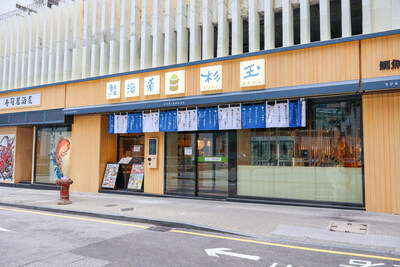Promotes Macao-Hengqin integration of Big Health tourism industry by leveraging respective advantages to create opportunities
MACAO, May 9, 2025 /PRNewswire/ — Sands China Ltd. and Guangdong-Macau Traditional Chinese Medicine Technology Industrial Park Development Co. Ltd. (GMTCM) have joined hands to promote the integration of the Big Health tourism industry in Macao and Hengqin by leveraging the advantages of both regions – signing a Memorandum of Understanding (MOU) Friday at the Traditional Chinese Medicine Science and Technology Industrial Park of Cooperation Between Guangdong and Macau (GMTCM Park) in the Guangdong-Macao In-Depth Cooperation Zone in Hengqin.

Dave Sun, executive vice president and chief financial officer of Sands China Ltd. and managing director of Venetian Macau Limited (seated, left) and Wu Song, chairman of Guangdong-Macau Traditional Chinese Medicine Technology Industrial Park Development Co., Ltd. (seated, right) sign an MOU Friday at the Traditional Chinese Medicine Science and Technology Industrial Park of Cooperation Between Guangdong and Macau (GMTCM Park) in the Guangdong-Macao In-Depth Cooperation Zone in Hengqin.

Guests of honour gather on stage after an MOU signing between Sands China and Guangdong-Macau Traditional Chinese Medicine Technology Industrial Park Development Co. Ltd. Friday at the Traditional Chinese Medicine Science and Technology Industrial Park of Cooperation Between Guangdong and Macao in the Guangdong-Macao In-Depth Cooperation Zone in Hengqin.
They signed the MOU with the goal of injecting momentum into the industry by taking advantage Macao’s positioning as a world centre of leisure and tourism, its outstanding hardware and software offerings, and the convenience of the “one-hour living circle” formed in the Guangdong-Hong Kong-Macao Greater Bay Area.
Macao is a city where Eastern and Western cultures have co-existed for over 400 years. By offering rich tourism resources and capitalising on its proximity to Hengqin, Macao has become one of the four key cities in the Greater Bay Area. The partnership between Sands China and GMTCM aims to employ the strengths of their hardware and software resources to unleash the potential of Macao-Hengqin development through promoting regional collaboration. They plan to fully utilise their respective resources to help health brands in Macao and Hengqin go global and attract international and domestic investment to Macao – laying the foundation for collaboration between Big Health products and related MICE events, fully in line with Macao’s vision of promoting “1+4” moderate economic diversification.
Meanwhile, they will cooperate to make use of their expertise and resources in the tourism and leisure, Traditional Chinese Medicine, and Big Health industries to create opportunities for integrating Big Health and tourism in Macao and Hengqin, highlighting the convenience of the border crossing and facilitating the development of both regions.
Grant Chum, chief executive officer and executive director of Sands China Ltd., said: “Rooted in Macao, which we have called home for more than two decades, Sands China is honoured to be the first among Macao’s integrated resort operators to sign an MOU with GMTCM. We have actively participated in this high-level collaboration, aiming to apply our strengths and value to enhance the city’s pivotal role as a world centre of tourism and leisure and a gateway for cultural exchange between East and West – deepening Macao’s integration into national development. Given that the global health tourism industry holds significant growth potential and a vast market scale, we hope to connect our tourism sector with Big Health by utilising resources within integrated resorts, organising conferences and exhibitions, and introducing health tourism products to make Macao a player in this emerging industry. In the future, we will collaborate with GMTCM to establish an industrial chain for the health tourism industry, promoting Macao and Hengqin as premier destinations in this regard.”
Wu Song, chairman of Guangdong-Macau Traditional Chinese Medicine Technology Industrial Park Development Co., Ltd., said: “This collaboration marks the official launch of in-depth cooperation between the two parties in the field of Big Health and tourism, carrying profound significance for advancing the cross-sector integration of Macao and Hengqin’s ‘tourism+’ initiatives. Since China Taiping officially took over the operation of the industrial park in January 2023, significant achievements have been made with the enthusiastic support of relevant central ministries, the Macao SAR government, and various sectors of society.
“This joint effort is a concrete measure in response to the Macao SAR government’s 2025 Policy Address to support key industrial projects in Macao and Hengqin, as well as deepening the cross-sector integration of ‘tourism+’. The industrial park and Sands China have vast potential for collaboration in areas such as product development, service innovation, and market expansion. The partnership will inject new momentum into Macao’s moderate economic diversification and the construction of the Greater Bay Area’s Traditional Chinese Medicine hub, together writing a new chapter in the great practice of One Country, Two Systems.”
Potential collaborative projects between Sands China and GMTCM include organising Big Health MICE events through their venue resources and professional platforms to promote the mutual development of the medical, healthcare, and wellness industry in Macao and Hengqin. Related events might include professional forums, industrial exhibitions, and international conferences and meetings, intended to strengthen exchange and interaction between Macao and Hengqin. Other possibilities include introducing new Big Health tourism facilities and products at Sands China’s integrated resorts and GMTCM Park to provide premium health management and medical care services for tourists and residents in Macao and Hengqin.
Guests of honour at Friday’s MOU signing ceremony were: Tai Kin Ip, Secretary for Economy and Finance of the Macao SAR and deputy director of the executive committee of the Guangdong-Macao In-Depth Cooperation Zone in Hengqin; Yang Quanzhou, deputy director of the Economic Affairs Department of the Central Liaison Office of the Central People’s Government in the Macao SAR; Yang Minggang, deputy general manager of China Taiping Insurance Group Limited; Wu Song; Zhang Haihong, acting president of the board of Macao Investment and Development Co., Ltd. and chairman of the supervisory committee of Guangdong-Macau Traditional Chinese Medicine Technology Industrial Park Development Co., Ltd.; Grant Chum; and Dave Sun, executive vice president and chief financial officer of Sands China Ltd. and managing director of Venetian Macau Limited.
As the first project implemented under the Framework Agreement on Cooperation between Guangdong and Macao, GMTCM Park was officially established in Hengqin in April 2011. It is located in the northwest high-tech zone of the Guangdong-Macao In-Depth Cooperation Zone in Hengqin, covering an area of 500,000 square meters. An investment of 8 billion RMB has been made to date, resulting in the development of various facilities, including office buildings, research and development spaces, hotels, commercial streets, museums, pharmaceutical factories, testing centres, Traditional Chinese Medicine laboratories, and apartments for experts and other talent. As of the end of March, there were 235 enterprises registered at GMTCM Park, including 89 from Macao, in fields such as Traditional Chinese Medicine, cosmetics, health products, medical devices, biomedicine, and medical services. GMTCM Park has established an incubation base featuring GMP (Good Manufacturing Practice) pilot-scale production, research, development, and testing that meet the certification standards of mainland China, making it a professional public service platform with internationally advanced standards.
###
About Sands China Ltd.
Sands China Ltd. (Sands China or the Company) is incorporated in the Cayman Islands with limited liability and is listed on The Stock Exchange of Hong Kong Limited (HKEx: 1928). Sands China is the largest operator of integrated resorts in Macao. The Company’s integrated resorts on the Cotai Strip comprise The Venetian® Macao, The Plaza® Macao, The Parisian® Macao and The Londoner Macao®. The Company also owns and operates Sands® Macao on the Macao peninsula. The Company’s portfolio features a diversified mix of leisure and business attractions and transportation operations, including large meeting and convention facilities; a wide range of restaurants; shopping malls; world-class entertainment at The Venetian Arena, The Londoner Arena, The Venetian Theatre, The Parisian Theatre, the Londoner Theatre and the Sands Theatre; and a high-speed Cotai Water Jet ferry service between Hong Kong and Macao. The Company’s Cotai Strip portfolio has the goal of contributing to Macao’s transformation into a world centre of tourism and leisure. Sands China is a subsidiary of global resort developer Las Vegas Sands Corp. (NYSE: LVS).
For more information, please visit www.sandschina.com.
About Guangdong-Macau Traditional Chinese Medicine Technology Industrial Park Development Co. Ltd. (GMTCM)
GMTCM is a limited liability company registered in Guangdong-Macao Deep Cooperation Zone in Hengqin to engage in the development and operation of industrial parks. In order to implement the General Plan for Construction of the Guangdong-Macao In-Depth Cooperation Zone in Hengqin and the Framework Agreement on Cooperation Between Guangdong and Macao, promote closer cooperation between Guangdong and Macao and promote appropriate diversification of Macao’s economy, GMTCM was jointly founded by Zhuhai Da Heng Qin Group Co., Ltd. and Macao Investment Development Co. Ltd., to focus on the development, operation and management of the Macao public asset Guangdong-Macau Traditional Chinese Medicine Technology Industrial Park. As a comprehensive industrial park integrating scientific research, production, exhibition and trading, it acts as a platform to empower Traditional Chinese Medicine and Big Health enterprises in Guangdong and Macao, promote the innovation and application of Traditional Chinese Medicine science and technology in Guangdong and Macao, promote the modernization and internationalization of the Traditional Chinese Medicine and Big Health industry, and boost regional cooperation and economic development.
Media contacts:
Corporate Communications, Sands China Ltd.
Mabel Wu
Tel: +853 8118 2268
Email: mabel.wu@sands.com.mo
Jesse Chiang
Tel: +853 8118 2054
Email: jesse.chiang@sands.com.mo












